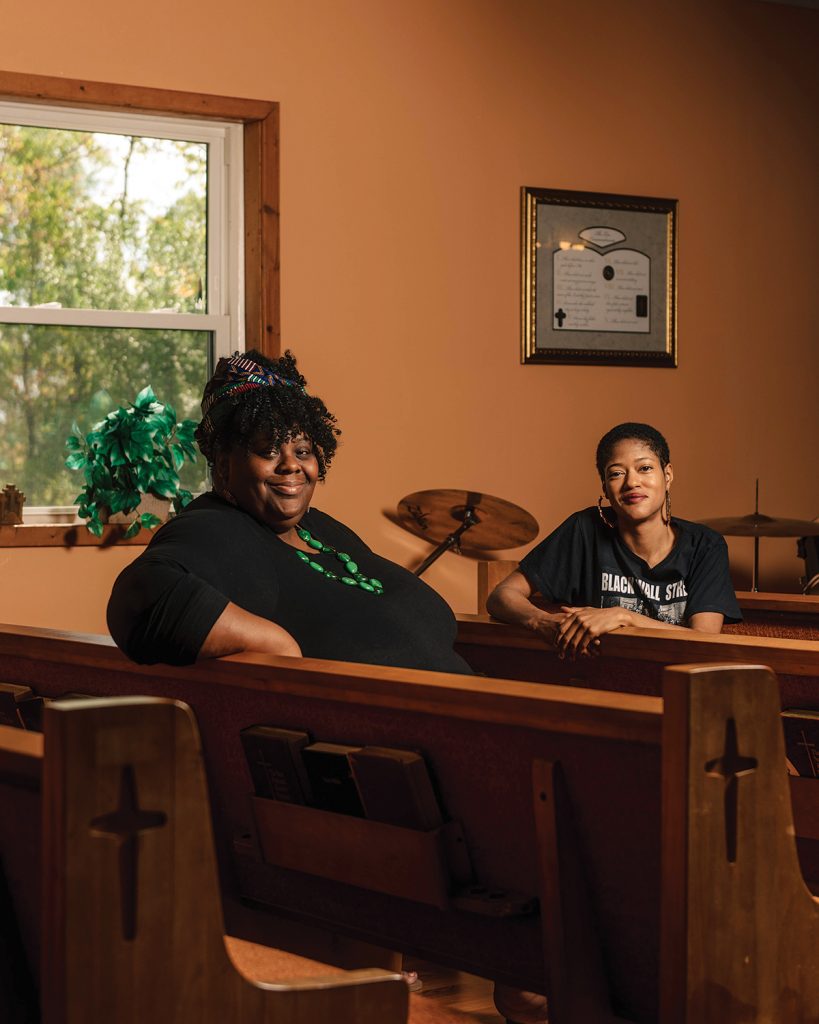Celebrating Juneteenth in Henderson County

OBSERVING TRADITION
Crystal Cauley, left, has coordinated the first official Juneteenth celebration in Hendersonville. She and Indián Jackson, right, are descendants of local families going back hundreds of years. “There is no Henderson County without Black history,” says Jackson.
Portrait by Clark Hodgin
Indián Jackson remembers the worn floors and smoking woodstove of Mount Zion Baptist Church, a small clapboard building in the Clear Creek community of Henderson County. It was here that her grandfather, Reverend Q.E. Owens, preached on Sundays and where Jackson unknowingly played among the dead as a child.
“I never knew the history. Few people do,” Jackson says in regard to some nine graves cloaked in bramble behind Mount Zion Baptist. One is marked — that of World War I veteran Albert H. Mills — while the others are demarcated by nothing more than a stone. These are the graves of earlier members of Mills’ family: enslaved men and women from Clear Creek, lifelong residents of the county whose lineages have been traced in oral histories and in books.

The grave of an ancestor from the Mills family, behind Mount Zion Baptist Church.
Photo by Clark Hodgin
Earlier this year, Crystal Cauley — a descendant of the Mills family and manager of the Black History Collective of Henderson County — recorded a piece of spoken-word poetry at Mount Zion. Written by Cauley and choreographed by Jackson, Ashes to Ashes pays homage to the “stories of shackled spirits never told” — the lives of local Black citizens who lived much, if not all, of their lives in bondage. The video was posted to Facebook not long after Mayor Barbara Volk, at the request of Cauley, agreed to proclaim June 19 as Juneteenth Day at the Hendersonville City Council meeting on Thursday, June 3.
“It’s past time for us to honor our Black ancestors,” says Jackson. “This is long overdue.”

A South African carved bowl.
African and African American artifacts from Crystal Cauley’s traveling business collection will be on display in two local venues in June.
Photo by Clark Hodgin
As significant as it is, Juneteenth is largely misunderstood. Though President Abraham Lincoln issued the preliminary Emancipation Proclamation on September 22, 1862, declaring that as of January 1, 1863, all enslaved people “shall be then, thenceforward, and forever free,” enforcement relied on Union troops and was not consistent; that meant some 250,000 slaves continued living as if nothing had changed. This was especially the case in Texas, the state furthest south of the Mason-Dixon with a low presence of Union soldiers. It wasn’t until June 19, 1865, more than two years after Lincoln’s statement, that Union Army general Gordon Granger proclaimed freedom from slavery in Texas.

“Total Praise,” a painting by local artist Diamond Cash (a tribute to Henderson County’s African American church history.
Photo by Clark Hodgin
Juneteenth evolved from Granger’s proclamation, with the earliest celebrations dating back to 1866. Centered around food and performances of traditional songs like “Lift Every Voice and Sing,” festivities became especially popular in the 1920s and 1930s, but gave way to the enormous challenges of the Civil Rights movement starting in the middle half of the 20th century.
More recently, Juneteenth has gained national prominence, with some 47 states and 200 cities across the country recognizing the date. Mayor Volk’s Juneteenth Proclamation will be the first time Hendersonville has officially recognized the holiday.

four-headed sandalwood “Unity” carving from South Africa (foreground) and standing statue from Kenya (background), displayed on mud-cloth from Mali.
Photo by Clark Hodgin
“Proclaiming June 19 as Juneteenth Day gives us an opportunity to show our support for our African American residents,” says Volk. “[We are] recognizing their history of enslavement and celebrating the vibrant culture, traditions, and contributions they have made to our community.”
Cauley, who frequently hosts educational events, is organizing exhibits in June at Henderson County’s Main Branch Library and at Hola Cultural Community Arts. Both will be on display through June 30. The antique artifacts — including two Civil War-era African dolls, carved statues and baskets, and more — are drawn from Cauley’s traveling business collection.
Countless Black men and women, like those laid to rest at Mount Zion, lived and died here without any recognition whatsoever. “We don’t learn about the Black history of Henderson County in our schools,” notes Jackson. “But there is no Henderson County without Black history. There is no ‘Apple Country’ without the former slaves who were brought here to do the work.”
Cauley believes we can honor them by acknowledging all that they went through.
“I wrote the poem with the help of my ancestors, to get people talking,” Cauley says of the Ashes to Ashes piece. “A lot of people, both Black and white, don’t want to talk about slavery. They think it’s in the past; they don’t want to rehash it. But so many Black people died without ever knowing what freedom was truly like. That’s an important part of our history.”
Juneteenth Events
June 3, 5:45 pm
The Juneteenth Proclamation
During the City of Hendersonville City Council meeting (305 Williams St., Hendersonville). Due to COVID restrictions, in-person attendance is limited; the public can access the meeting via Zoom: hendersonvillenc.gov.
June 1-30, Two Exhibits
Juneteenth: Celebrating 165 Years of Freedom, Henderson County Main Branch Library (301 Washington St.).
The African Dream of an Emancipated Descendant
Hola Cultural Community Arts (in Jackson Park, Hendersonville).
June 12
A Juneteenth event at Hola Community Arts will feature dancers, spoken-word poetry, singing, African drumming, and a fashion show, 2-4pm. For more information, contact Cauley at bbnofwnc@gmail.com (also P.O. Box #1, Hendersonville, NC, 28793).
